Strategic Planning and Impact Analysis of Hong Kong Tourism Commission
VerifiedAdded on 2019/09/24
|21
|5407
|147
Report
AI Summary
This report provides a comprehensive analysis of Hong Kong's tourism sector, focusing on the role and function of the Tourism Commission. It examines the commission's organizational structure, vision, and mission, as well as its strategic planning initiatives. The report delves into the economic, social, and environmental impacts of tourism, including the advantages and disadvantages of utilizing historic buildings to attract visitors. It also explores various tourism projects, such as the Hong Kong Wetland Park and the Aberdeen Tourism Project, and identifies the key stakeholders involved. Furthermore, the report assesses the relationships between stakeholders and offers recommendations for mitigating negative impacts. The report concludes with a case study that highlights the social and economic impacts of tourism in Hong Kong, providing valuable insights into the industry's dynamics and future prospects.
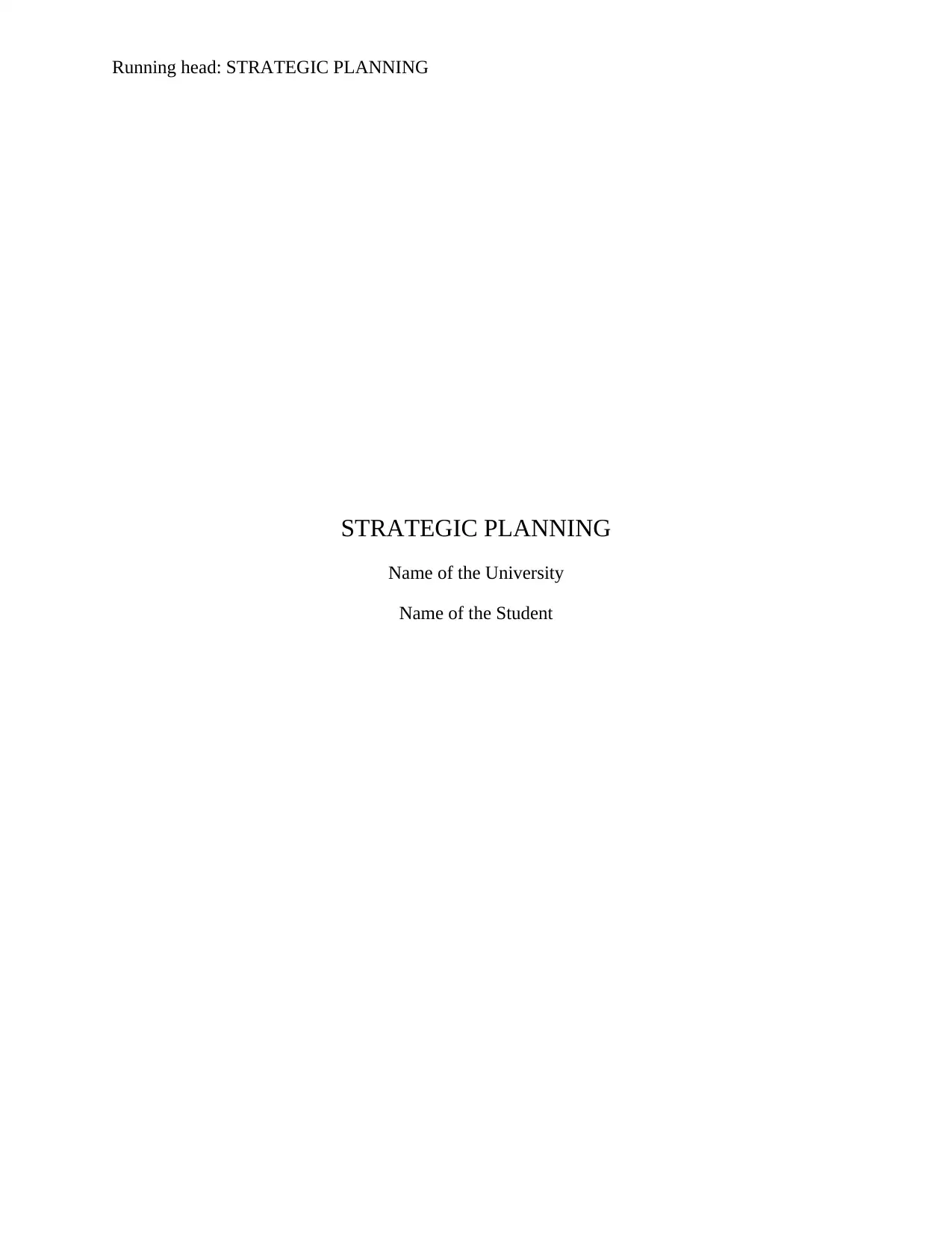
Running head: STRATEGIC PLANNING
STRATEGIC PLANNING
Name of the University
Name of the Student
STRATEGIC PLANNING
Name of the University
Name of the Student
Paraphrase This Document
Need a fresh take? Get an instant paraphrase of this document with our AI Paraphraser
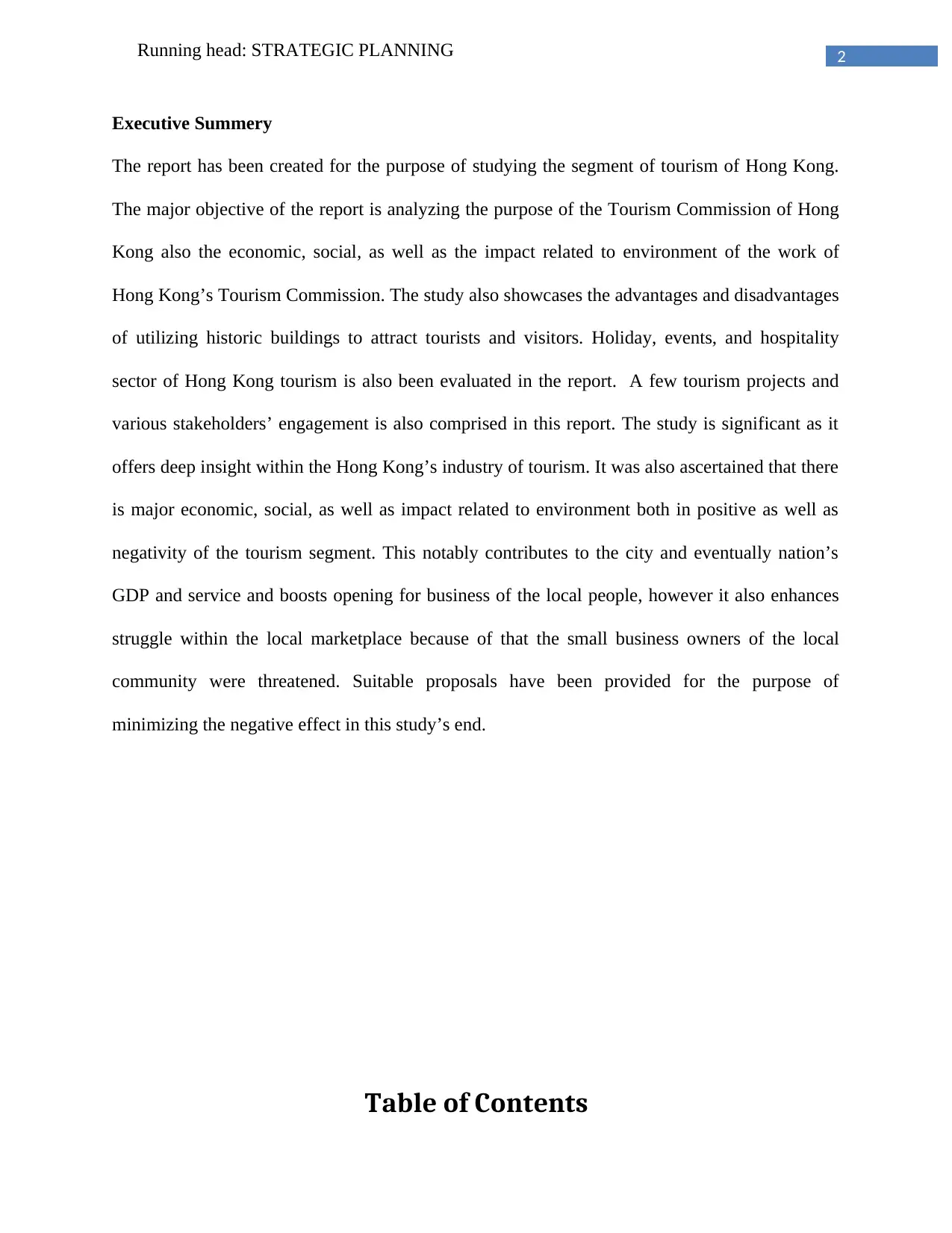
2Running head: STRATEGIC PLANNING
Executive Summery
The report has been created for the purpose of studying the segment of tourism of Hong Kong.
The major objective of the report is analyzing the purpose of the Tourism Commission of Hong
Kong also the economic, social, as well as the impact related to environment of the work of
Hong Kong’s Tourism Commission. The study also showcases the advantages and disadvantages
of utilizing historic buildings to attract tourists and visitors. Holiday, events, and hospitality
sector of Hong Kong tourism is also been evaluated in the report. A few tourism projects and
various stakeholders’ engagement is also comprised in this report. The study is significant as it
offers deep insight within the Hong Kong’s industry of tourism. It was also ascertained that there
is major economic, social, as well as impact related to environment both in positive as well as
negativity of the tourism segment. This notably contributes to the city and eventually nation’s
GDP and service and boosts opening for business of the local people, however it also enhances
struggle within the local marketplace because of that the small business owners of the local
community were threatened. Suitable proposals have been provided for the purpose of
minimizing the negative effect in this study’s end.
Table of Contents
Executive Summery
The report has been created for the purpose of studying the segment of tourism of Hong Kong.
The major objective of the report is analyzing the purpose of the Tourism Commission of Hong
Kong also the economic, social, as well as the impact related to environment of the work of
Hong Kong’s Tourism Commission. The study also showcases the advantages and disadvantages
of utilizing historic buildings to attract tourists and visitors. Holiday, events, and hospitality
sector of Hong Kong tourism is also been evaluated in the report. A few tourism projects and
various stakeholders’ engagement is also comprised in this report. The study is significant as it
offers deep insight within the Hong Kong’s industry of tourism. It was also ascertained that there
is major economic, social, as well as impact related to environment both in positive as well as
negativity of the tourism segment. This notably contributes to the city and eventually nation’s
GDP and service and boosts opening for business of the local people, however it also enhances
struggle within the local marketplace because of that the small business owners of the local
community were threatened. Suitable proposals have been provided for the purpose of
minimizing the negative effect in this study’s end.
Table of Contents

3Running head: STRATEGIC PLANNING
Executive Summery.....................................................................................................................................2
Introduction.................................................................................................................................................4
The Tourism Commission............................................................................................................................5
Organizational Structure.............................................................................................................................6
The Vision of Tourism Commission..........................................................................................................6
The mission of Tourism Commission.......................................................................................................6
Role and Function of Tourism Commission.............................................................................................6
Tourism Project and Their Stakeholders......................................................................................................7
Types of Stakeholders..............................................................................................................................8
Tourism Project Examples.......................................................................................................................8
Tourism Project Example.........................................................................................................................9
Stakeholders Relationship.........................................................................................................................10
Impact of Tourism Commission’s Work.....................................................................................................11
Social and Cultural impact.....................................................................................................................11
Economical impact................................................................................................................................11
Environmental impact...........................................................................................................................12
The Historic Buildings – Pro’s and Con’s....................................................................................................13
Pro’s associated with the usage of historic buildings............................................................................13
Con’s associated with the usage of historic buildings............................................................................14
A Case Study in Hong Kong........................................................................................................................15
Social Impact.........................................................................................................................................16
Economical Impact................................................................................................................................16
Conclusion.................................................................................................................................................17
Recommendations.....................................................................................................................................17
References:................................................................................................................................................19
Executive Summery.....................................................................................................................................2
Introduction.................................................................................................................................................4
The Tourism Commission............................................................................................................................5
Organizational Structure.............................................................................................................................6
The Vision of Tourism Commission..........................................................................................................6
The mission of Tourism Commission.......................................................................................................6
Role and Function of Tourism Commission.............................................................................................6
Tourism Project and Their Stakeholders......................................................................................................7
Types of Stakeholders..............................................................................................................................8
Tourism Project Examples.......................................................................................................................8
Tourism Project Example.........................................................................................................................9
Stakeholders Relationship.........................................................................................................................10
Impact of Tourism Commission’s Work.....................................................................................................11
Social and Cultural impact.....................................................................................................................11
Economical impact................................................................................................................................11
Environmental impact...........................................................................................................................12
The Historic Buildings – Pro’s and Con’s....................................................................................................13
Pro’s associated with the usage of historic buildings............................................................................13
Con’s associated with the usage of historic buildings............................................................................14
A Case Study in Hong Kong........................................................................................................................15
Social Impact.........................................................................................................................................16
Economical Impact................................................................................................................................16
Conclusion.................................................................................................................................................17
Recommendations.....................................................................................................................................17
References:................................................................................................................................................19
⊘ This is a preview!⊘
Do you want full access?
Subscribe today to unlock all pages.

Trusted by 1+ million students worldwide
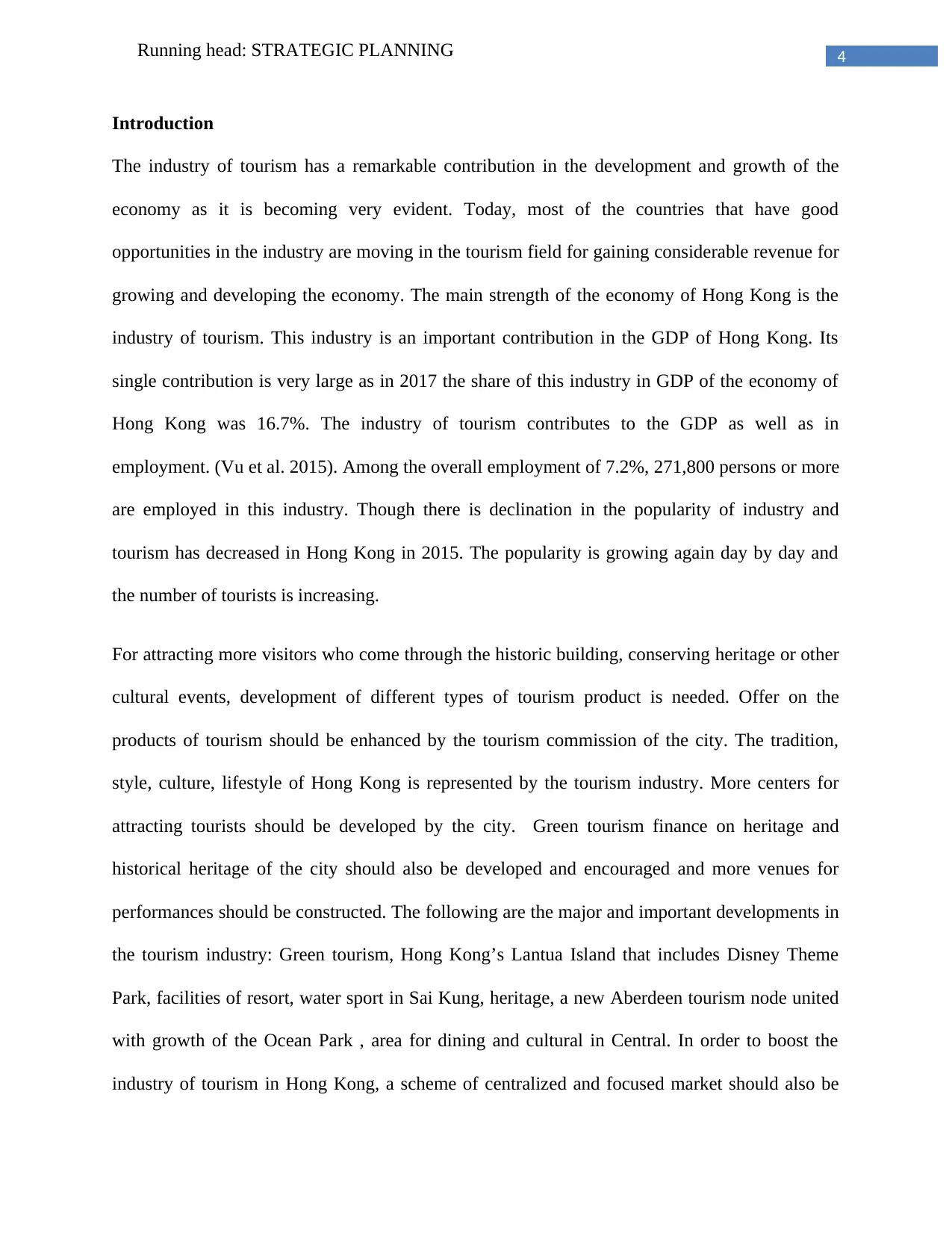
4Running head: STRATEGIC PLANNING
Introduction
The industry of tourism has a remarkable contribution in the development and growth of the
economy as it is becoming very evident. Today, most of the countries that have good
opportunities in the industry are moving in the tourism field for gaining considerable revenue for
growing and developing the economy. The main strength of the economy of Hong Kong is the
industry of tourism. This industry is an important contribution in the GDP of Hong Kong. Its
single contribution is very large as in 2017 the share of this industry in GDP of the economy of
Hong Kong was 16.7%. The industry of tourism contributes to the GDP as well as in
employment. (Vu et al. 2015). Among the overall employment of 7.2%, 271,800 persons or more
are employed in this industry. Though there is declination in the popularity of industry and
tourism has decreased in Hong Kong in 2015. The popularity is growing again day by day and
the number of tourists is increasing.
For attracting more visitors who come through the historic building, conserving heritage or other
cultural events, development of different types of tourism product is needed. Offer on the
products of tourism should be enhanced by the tourism commission of the city. The tradition,
style, culture, lifestyle of Hong Kong is represented by the tourism industry. More centers for
attracting tourists should be developed by the city. Green tourism finance on heritage and
historical heritage of the city should also be developed and encouraged and more venues for
performances should be constructed. The following are the major and important developments in
the tourism industry: Green tourism, Hong Kong’s Lantua Island that includes Disney Theme
Park, facilities of resort, water sport in Sai Kung, heritage, a new Aberdeen tourism node united
with growth of the Ocean Park , area for dining and cultural in Central. In order to boost the
industry of tourism in Hong Kong, a scheme of centralized and focused market should also be
Introduction
The industry of tourism has a remarkable contribution in the development and growth of the
economy as it is becoming very evident. Today, most of the countries that have good
opportunities in the industry are moving in the tourism field for gaining considerable revenue for
growing and developing the economy. The main strength of the economy of Hong Kong is the
industry of tourism. This industry is an important contribution in the GDP of Hong Kong. Its
single contribution is very large as in 2017 the share of this industry in GDP of the economy of
Hong Kong was 16.7%. The industry of tourism contributes to the GDP as well as in
employment. (Vu et al. 2015). Among the overall employment of 7.2%, 271,800 persons or more
are employed in this industry. Though there is declination in the popularity of industry and
tourism has decreased in Hong Kong in 2015. The popularity is growing again day by day and
the number of tourists is increasing.
For attracting more visitors who come through the historic building, conserving heritage or other
cultural events, development of different types of tourism product is needed. Offer on the
products of tourism should be enhanced by the tourism commission of the city. The tradition,
style, culture, lifestyle of Hong Kong is represented by the tourism industry. More centers for
attracting tourists should be developed by the city. Green tourism finance on heritage and
historical heritage of the city should also be developed and encouraged and more venues for
performances should be constructed. The following are the major and important developments in
the tourism industry: Green tourism, Hong Kong’s Lantua Island that includes Disney Theme
Park, facilities of resort, water sport in Sai Kung, heritage, a new Aberdeen tourism node united
with growth of the Ocean Park , area for dining and cultural in Central. In order to boost the
industry of tourism in Hong Kong, a scheme of centralized and focused market should also be
Paraphrase This Document
Need a fresh take? Get an instant paraphrase of this document with our AI Paraphraser

5Running head: STRATEGIC PLANNING
devised by the tourism commission of the city. The standard of services provided determines the
favorable result of the industry. For enhancing the standard of services the, tourism commission
must focus on its quality. Developing tourism and conserving heritage has an intense relationship
between them. (Tsui and Fung 2016) Tourists visit the sights of cultural heritage where the place
is conserved. Visitors who come to the place are attracted to the heritage that reveals the values,
traditions, and cultures of the places. Visitors won’t visit the place and they would be less
attracted if the tourism commission is unable to conserve the heritage place. The duties and
responsibilities of the tourism sector of Hong Kong have been highlighted in this study.
Association of stakeholders has also been focused in this study. Effect of work of tourism sector
like impacts on economy, social and culture and environment and challenges as well as
advantages of utilizing the historical building has also been included. (Agapito and Chan 2019).
The Tourism Commission
For maintaining the position of the city as leading city of destination for the tourists in Asia, the
tourism commission has been established by the government of Special Administrative Region
of Hong Kong in 1999. The establishment of tourism commission was controlled by the
Commerce and Economic Development Bureau of Hong Kong. The work of the commission is
supporting the growth of the new events and attracting and improving the facilities of tourists for
making Hong Kong a premier spot for the visitors. Commissioner of tourism of Hong Kong is
the head of the tourism commission. The duties of the commissioner are to map out the strategy
for developing tourism and scheme proposed by the government.
devised by the tourism commission of the city. The standard of services provided determines the
favorable result of the industry. For enhancing the standard of services the, tourism commission
must focus on its quality. Developing tourism and conserving heritage has an intense relationship
between them. (Tsui and Fung 2016) Tourists visit the sights of cultural heritage where the place
is conserved. Visitors who come to the place are attracted to the heritage that reveals the values,
traditions, and cultures of the places. Visitors won’t visit the place and they would be less
attracted if the tourism commission is unable to conserve the heritage place. The duties and
responsibilities of the tourism sector of Hong Kong have been highlighted in this study.
Association of stakeholders has also been focused in this study. Effect of work of tourism sector
like impacts on economy, social and culture and environment and challenges as well as
advantages of utilizing the historical building has also been included. (Agapito and Chan 2019).
The Tourism Commission
For maintaining the position of the city as leading city of destination for the tourists in Asia, the
tourism commission has been established by the government of Special Administrative Region
of Hong Kong in 1999. The establishment of tourism commission was controlled by the
Commerce and Economic Development Bureau of Hong Kong. The work of the commission is
supporting the growth of the new events and attracting and improving the facilities of tourists for
making Hong Kong a premier spot for the visitors. Commissioner of tourism of Hong Kong is
the head of the tourism commission. The duties of the commissioner are to map out the strategy
for developing tourism and scheme proposed by the government.
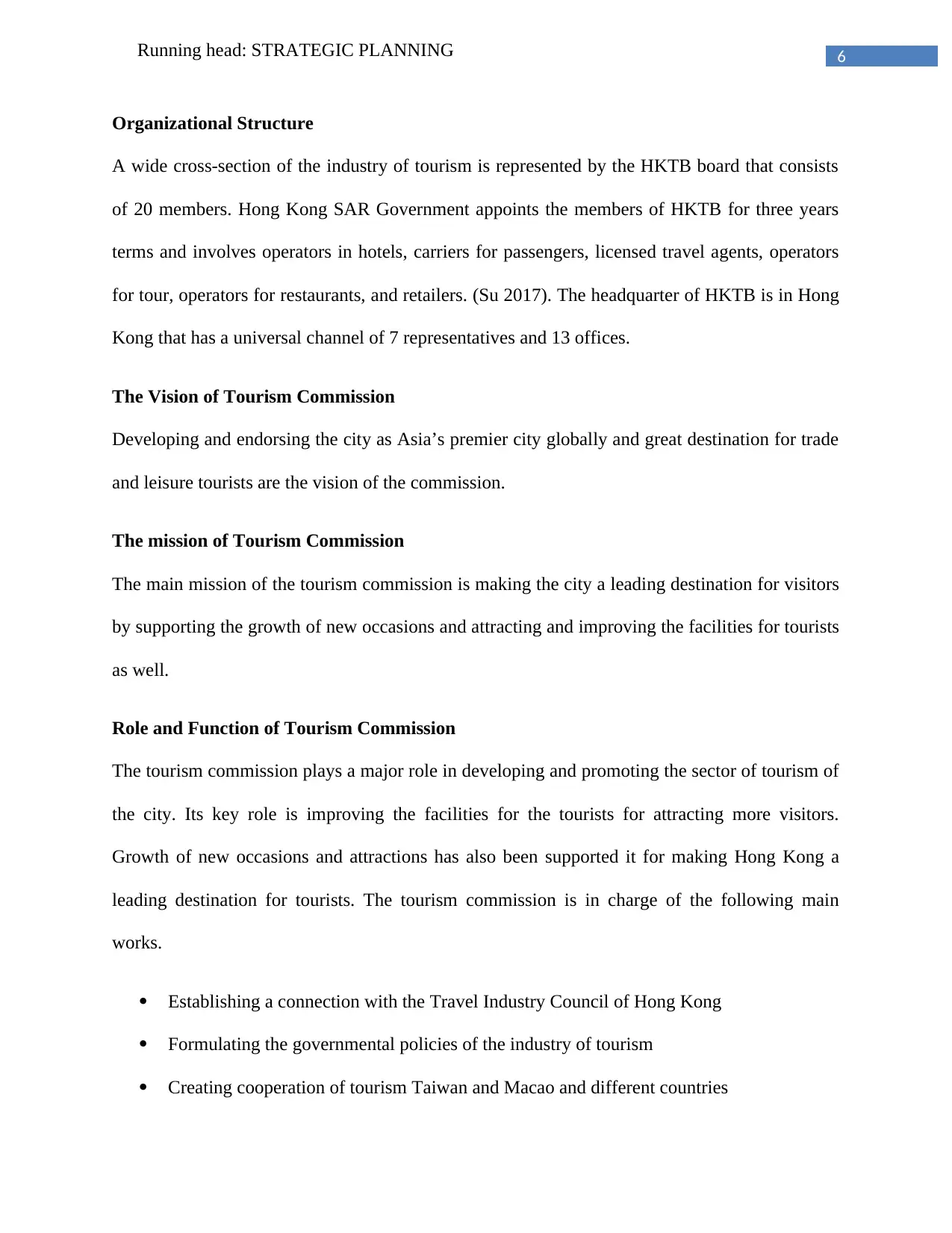
6Running head: STRATEGIC PLANNING
Organizational Structure
A wide cross-section of the industry of tourism is represented by the HKTB board that consists
of 20 members. Hong Kong SAR Government appoints the members of HKTB for three years
terms and involves operators in hotels, carriers for passengers, licensed travel agents, operators
for tour, operators for restaurants, and retailers. (Su 2017). The headquarter of HKTB is in Hong
Kong that has a universal channel of 7 representatives and 13 offices.
The Vision of Tourism Commission
Developing and endorsing the city as Asia’s premier city globally and great destination for trade
and leisure tourists are the vision of the commission.
The mission of Tourism Commission
The main mission of the tourism commission is making the city a leading destination for visitors
by supporting the growth of new occasions and attracting and improving the facilities for tourists
as well.
Role and Function of Tourism Commission
The tourism commission plays a major role in developing and promoting the sector of tourism of
the city. Its key role is improving the facilities for the tourists for attracting more visitors.
Growth of new occasions and attractions has also been supported it for making Hong Kong a
leading destination for tourists. The tourism commission is in charge of the following main
works.
Establishing a connection with the Travel Industry Council of Hong Kong
Formulating the governmental policies of the industry of tourism
Creating cooperation of tourism Taiwan and Macao and different countries
Organizational Structure
A wide cross-section of the industry of tourism is represented by the HKTB board that consists
of 20 members. Hong Kong SAR Government appoints the members of HKTB for three years
terms and involves operators in hotels, carriers for passengers, licensed travel agents, operators
for tour, operators for restaurants, and retailers. (Su 2017). The headquarter of HKTB is in Hong
Kong that has a universal channel of 7 representatives and 13 offices.
The Vision of Tourism Commission
Developing and endorsing the city as Asia’s premier city globally and great destination for trade
and leisure tourists are the vision of the commission.
The mission of Tourism Commission
The main mission of the tourism commission is making the city a leading destination for visitors
by supporting the growth of new occasions and attracting and improving the facilities for tourists
as well.
Role and Function of Tourism Commission
The tourism commission plays a major role in developing and promoting the sector of tourism of
the city. Its key role is improving the facilities for the tourists for attracting more visitors.
Growth of new occasions and attractions has also been supported it for making Hong Kong a
leading destination for tourists. The tourism commission is in charge of the following main
works.
Establishing a connection with the Travel Industry Council of Hong Kong
Formulating the governmental policies of the industry of tourism
Creating cooperation of tourism Taiwan and Macao and different countries
⊘ This is a preview!⊘
Do you want full access?
Subscribe today to unlock all pages.

Trusted by 1+ million students worldwide
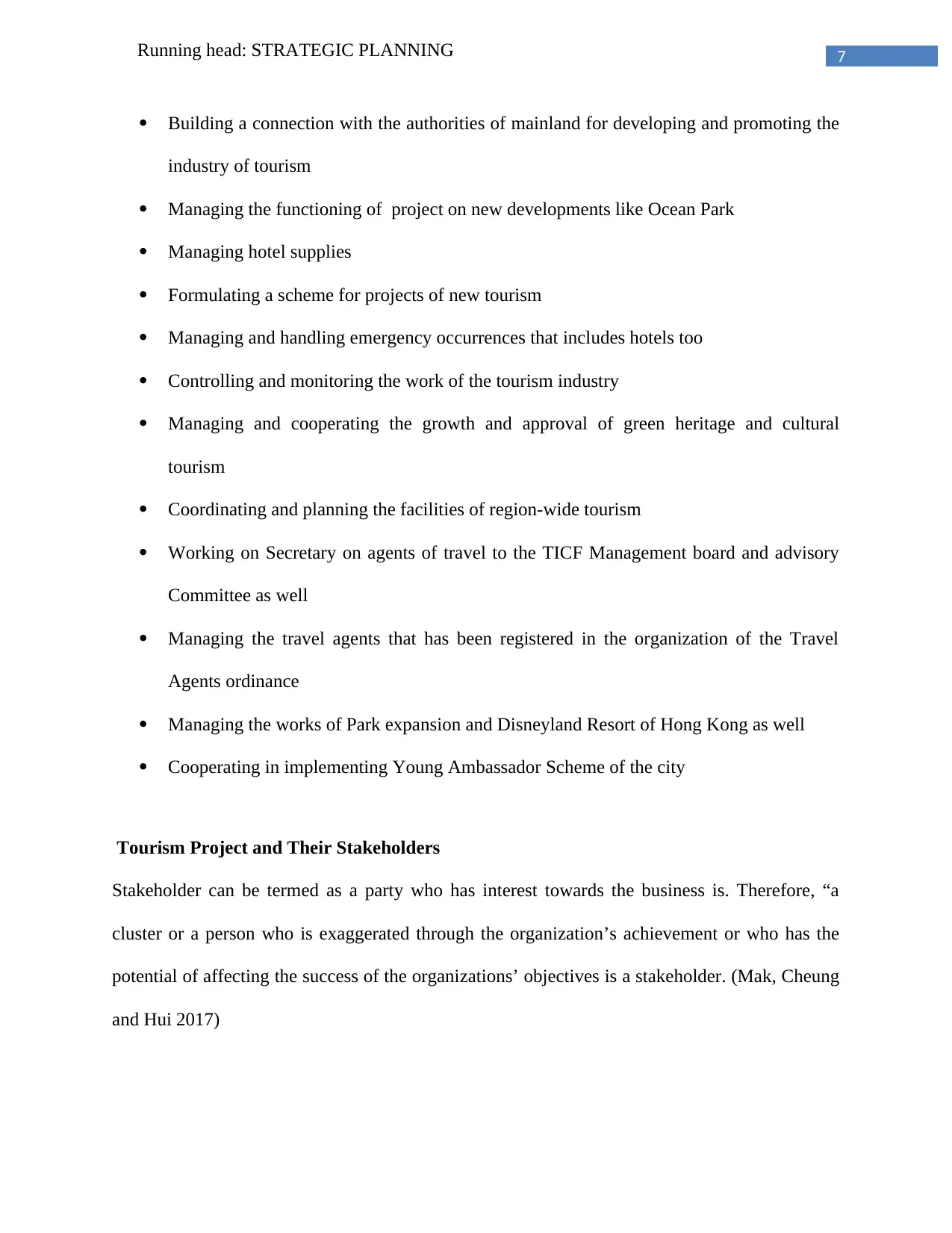
7Running head: STRATEGIC PLANNING
Building a connection with the authorities of mainland for developing and promoting the
industry of tourism
Managing the functioning of project on new developments like Ocean Park
Managing hotel supplies
Formulating a scheme for projects of new tourism
Managing and handling emergency occurrences that includes hotels too
Controlling and monitoring the work of the tourism industry
Managing and cooperating the growth and approval of green heritage and cultural
tourism
Coordinating and planning the facilities of region-wide tourism
Working on Secretary on agents of travel to the TICF Management board and advisory
Committee as well
Managing the travel agents that has been registered in the organization of the Travel
Agents ordinance
Managing the works of Park expansion and Disneyland Resort of Hong Kong as well
Cooperating in implementing Young Ambassador Scheme of the city
Tourism Project and Their Stakeholders
Stakeholder can be termed as a party who has interest towards the business is. Therefore, “a
cluster or a person who is exaggerated through the organization’s achievement or who has the
potential of affecting the success of the organizations’ objectives is a stakeholder. (Mak, Cheung
and Hui 2017)
Building a connection with the authorities of mainland for developing and promoting the
industry of tourism
Managing the functioning of project on new developments like Ocean Park
Managing hotel supplies
Formulating a scheme for projects of new tourism
Managing and handling emergency occurrences that includes hotels too
Controlling and monitoring the work of the tourism industry
Managing and cooperating the growth and approval of green heritage and cultural
tourism
Coordinating and planning the facilities of region-wide tourism
Working on Secretary on agents of travel to the TICF Management board and advisory
Committee as well
Managing the travel agents that has been registered in the organization of the Travel
Agents ordinance
Managing the works of Park expansion and Disneyland Resort of Hong Kong as well
Cooperating in implementing Young Ambassador Scheme of the city
Tourism Project and Their Stakeholders
Stakeholder can be termed as a party who has interest towards the business is. Therefore, “a
cluster or a person who is exaggerated through the organization’s achievement or who has the
potential of affecting the success of the organizations’ objectives is a stakeholder. (Mak, Cheung
and Hui 2017)
Paraphrase This Document
Need a fresh take? Get an instant paraphrase of this document with our AI Paraphraser
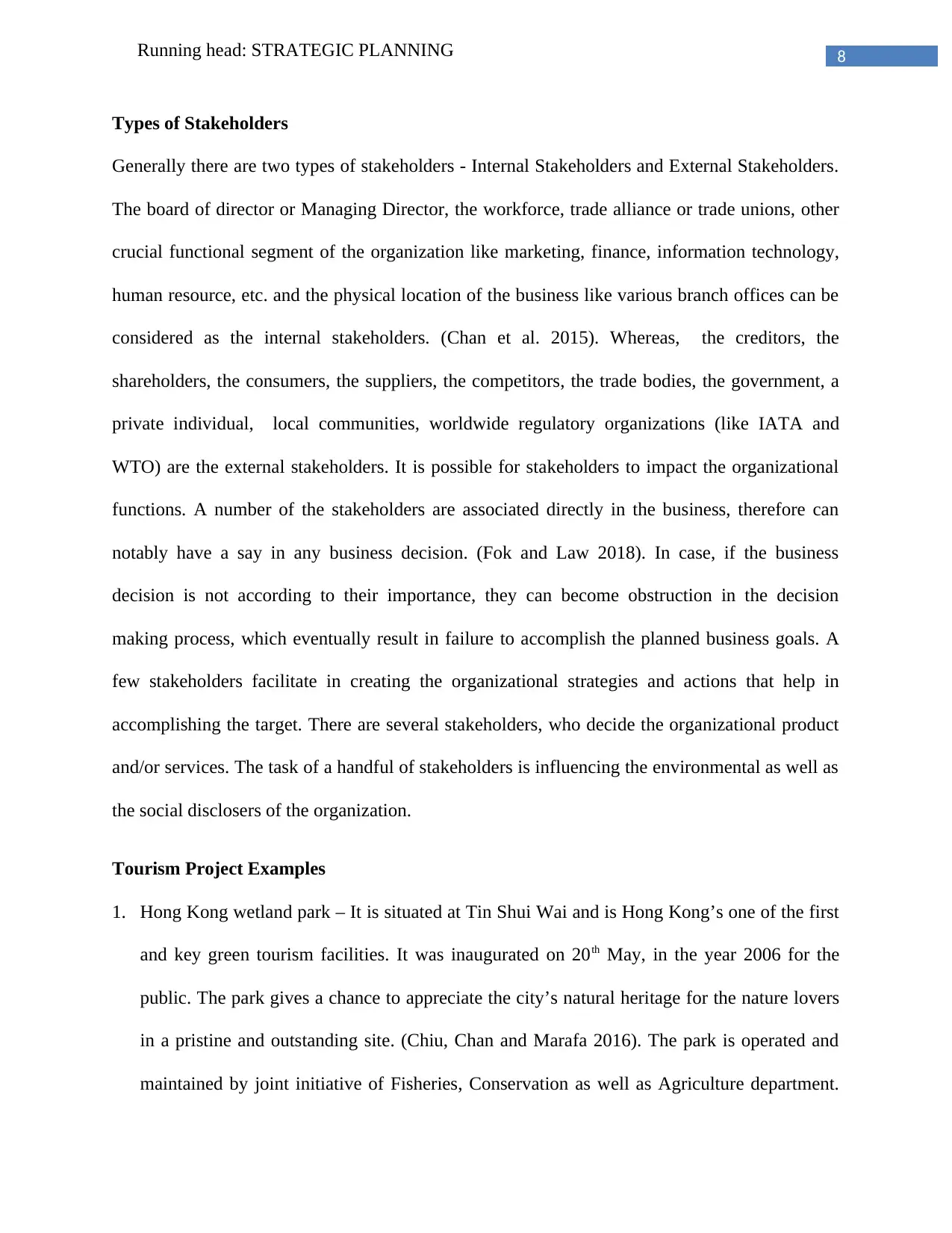
8Running head: STRATEGIC PLANNING
Types of Stakeholders
Generally there are two types of stakeholders - Internal Stakeholders and External Stakeholders.
The board of director or Managing Director, the workforce, trade alliance or trade unions, other
crucial functional segment of the organization like marketing, finance, information technology,
human resource, etc. and the physical location of the business like various branch offices can be
considered as the internal stakeholders. (Chan et al. 2015). Whereas, the creditors, the
shareholders, the consumers, the suppliers, the competitors, the trade bodies, the government, a
private individual, local communities, worldwide regulatory organizations (like IATA and
WTO) are the external stakeholders. It is possible for stakeholders to impact the organizational
functions. A number of the stakeholders are associated directly in the business, therefore can
notably have a say in any business decision. (Fok and Law 2018). In case, if the business
decision is not according to their importance, they can become obstruction in the decision
making process, which eventually result in failure to accomplish the planned business goals. A
few stakeholders facilitate in creating the organizational strategies and actions that help in
accomplishing the target. There are several stakeholders, who decide the organizational product
and/or services. The task of a handful of stakeholders is influencing the environmental as well as
the social disclosers of the organization.
Tourism Project Examples
1. Hong Kong wetland park – It is situated at Tin Shui Wai and is Hong Kong’s one of the first
and key green tourism facilities. It was inaugurated on 20th May, in the year 2006 for the
public. The park gives a chance to appreciate the city’s natural heritage for the nature lovers
in a pristine and outstanding site. (Chiu, Chan and Marafa 2016). The park is operated and
maintained by joint initiative of Fisheries, Conservation as well as Agriculture department.
Types of Stakeholders
Generally there are two types of stakeholders - Internal Stakeholders and External Stakeholders.
The board of director or Managing Director, the workforce, trade alliance or trade unions, other
crucial functional segment of the organization like marketing, finance, information technology,
human resource, etc. and the physical location of the business like various branch offices can be
considered as the internal stakeholders. (Chan et al. 2015). Whereas, the creditors, the
shareholders, the consumers, the suppliers, the competitors, the trade bodies, the government, a
private individual, local communities, worldwide regulatory organizations (like IATA and
WTO) are the external stakeholders. It is possible for stakeholders to impact the organizational
functions. A number of the stakeholders are associated directly in the business, therefore can
notably have a say in any business decision. (Fok and Law 2018). In case, if the business
decision is not according to their importance, they can become obstruction in the decision
making process, which eventually result in failure to accomplish the planned business goals. A
few stakeholders facilitate in creating the organizational strategies and actions that help in
accomplishing the target. There are several stakeholders, who decide the organizational product
and/or services. The task of a handful of stakeholders is influencing the environmental as well as
the social disclosers of the organization.
Tourism Project Examples
1. Hong Kong wetland park – It is situated at Tin Shui Wai and is Hong Kong’s one of the first
and key green tourism facilities. It was inaugurated on 20th May, in the year 2006 for the
public. The park gives a chance to appreciate the city’s natural heritage for the nature lovers
in a pristine and outstanding site. (Chiu, Chan and Marafa 2016). The park is operated and
maintained by joint initiative of Fisheries, Conservation as well as Agriculture department.
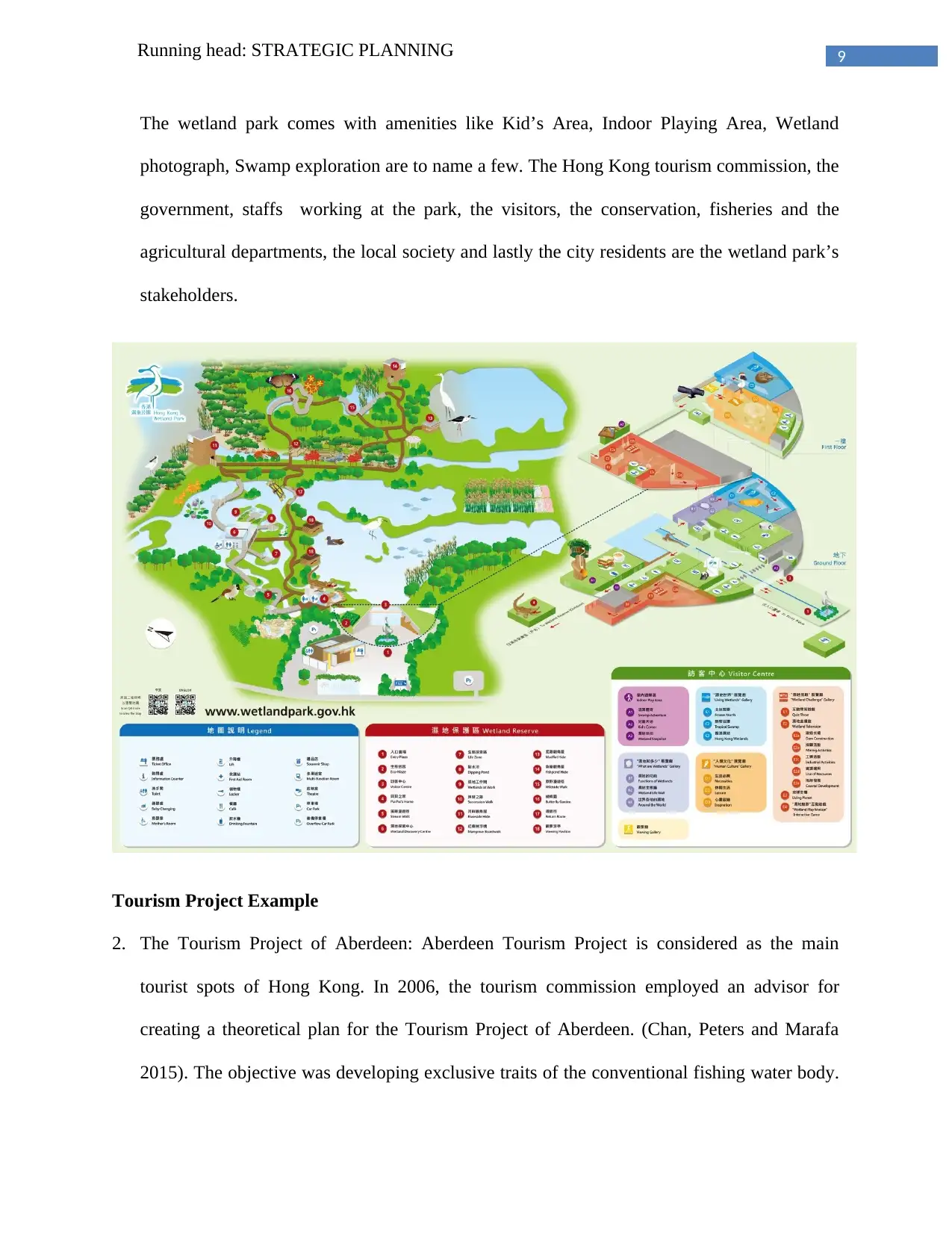
9Running head: STRATEGIC PLANNING
The wetland park comes with amenities like Kid’s Area, Indoor Playing Area, Wetland
photograph, Swamp exploration are to name a few. The Hong Kong tourism commission, the
government, staffs working at the park, the visitors, the conservation, fisheries and the
agricultural departments, the local society and lastly the city residents are the wetland park’s
stakeholders.
Tourism Project Example
2. The Tourism Project of Aberdeen: Aberdeen Tourism Project is considered as the main
tourist spots of Hong Kong. In 2006, the tourism commission employed an advisor for
creating a theoretical plan for the Tourism Project of Aberdeen. (Chan, Peters and Marafa
2015). The objective was developing exclusive traits of the conventional fishing water body.
The wetland park comes with amenities like Kid’s Area, Indoor Playing Area, Wetland
photograph, Swamp exploration are to name a few. The Hong Kong tourism commission, the
government, staffs working at the park, the visitors, the conservation, fisheries and the
agricultural departments, the local society and lastly the city residents are the wetland park’s
stakeholders.
Tourism Project Example
2. The Tourism Project of Aberdeen: Aberdeen Tourism Project is considered as the main
tourist spots of Hong Kong. In 2006, the tourism commission employed an advisor for
creating a theoretical plan for the Tourism Project of Aberdeen. (Chan, Peters and Marafa
2015). The objective was developing exclusive traits of the conventional fishing water body.
⊘ This is a preview!⊘
Do you want full access?
Subscribe today to unlock all pages.

Trusted by 1+ million students worldwide
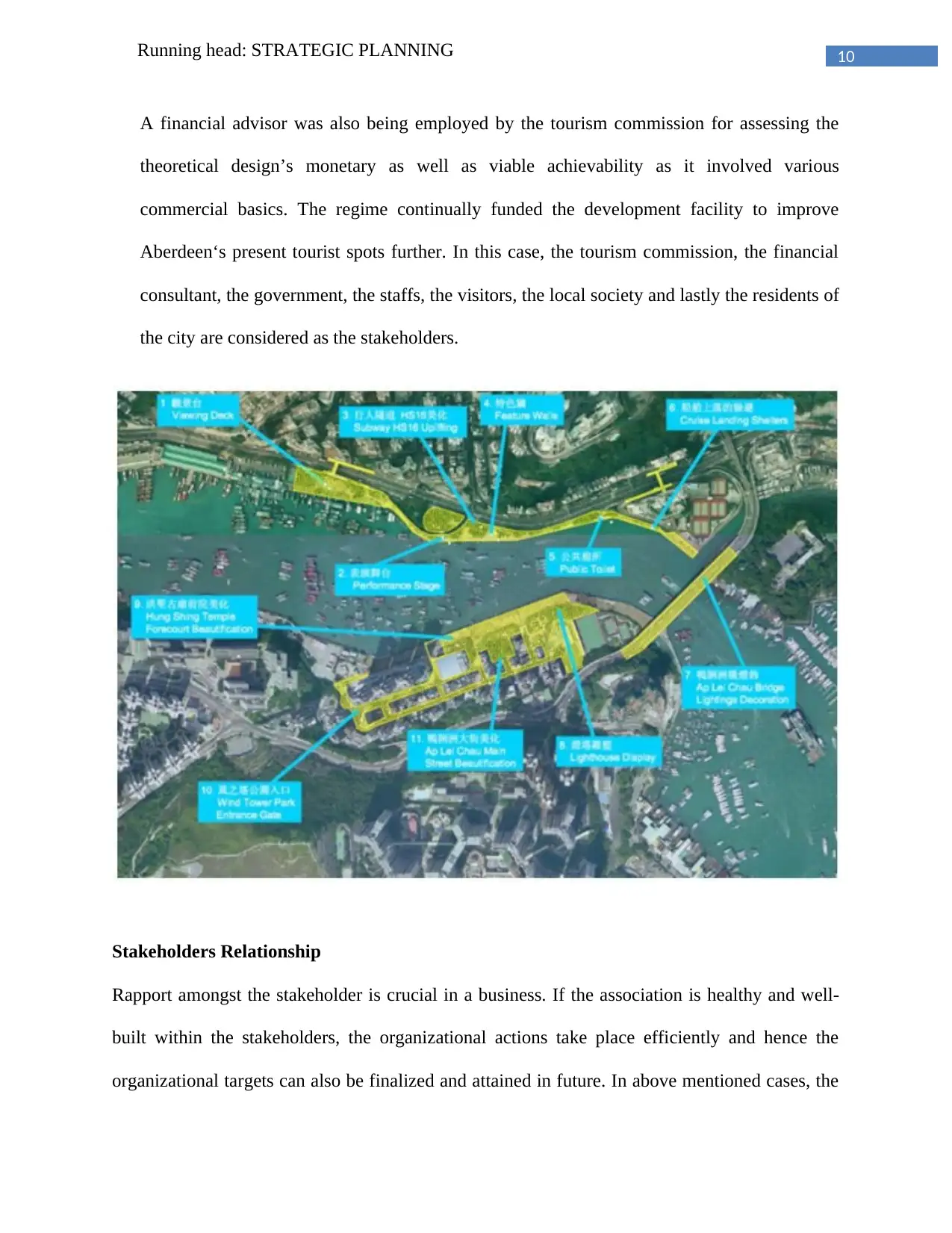
10Running head: STRATEGIC PLANNING
A financial advisor was also being employed by the tourism commission for assessing the
theoretical design’s monetary as well as viable achievability as it involved various
commercial basics. The regime continually funded the development facility to improve
Aberdeen‘s present tourist spots further. In this case, the tourism commission, the financial
consultant, the government, the staffs, the visitors, the local society and lastly the residents of
the city are considered as the stakeholders.
Stakeholders Relationship
Rapport amongst the stakeholder is crucial in a business. If the association is healthy and well-
built within the stakeholders, the organizational actions take place efficiently and hence the
organizational targets can also be finalized and attained in future. In above mentioned cases, the
A financial advisor was also being employed by the tourism commission for assessing the
theoretical design’s monetary as well as viable achievability as it involved various
commercial basics. The regime continually funded the development facility to improve
Aberdeen‘s present tourist spots further. In this case, the tourism commission, the financial
consultant, the government, the staffs, the visitors, the local society and lastly the residents of
the city are considered as the stakeholders.
Stakeholders Relationship
Rapport amongst the stakeholder is crucial in a business. If the association is healthy and well-
built within the stakeholders, the organizational actions take place efficiently and hence the
organizational targets can also be finalized and attained in future. In above mentioned cases, the
Paraphrase This Document
Need a fresh take? Get an instant paraphrase of this document with our AI Paraphraser
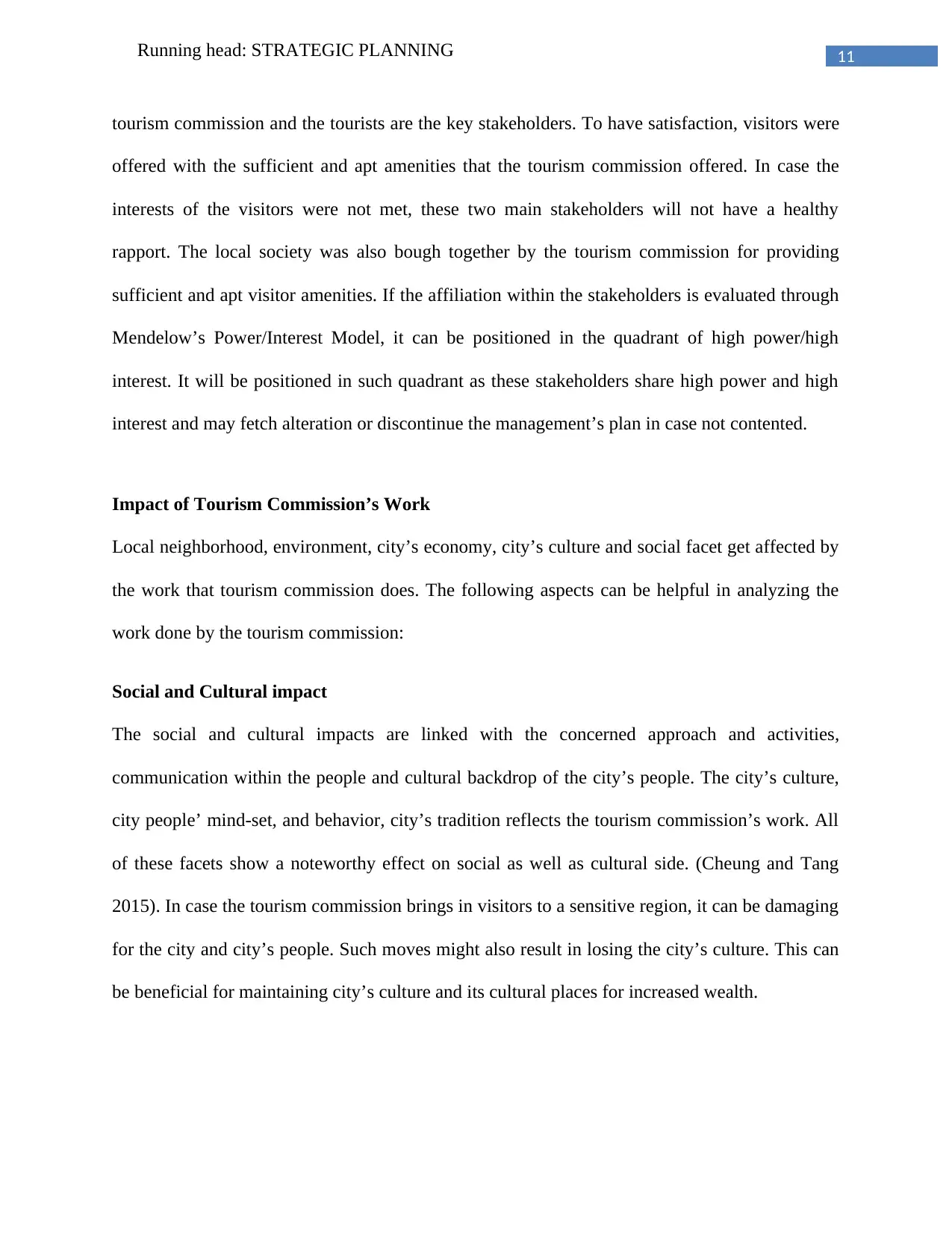
11Running head: STRATEGIC PLANNING
tourism commission and the tourists are the key stakeholders. To have satisfaction, visitors were
offered with the sufficient and apt amenities that the tourism commission offered. In case the
interests of the visitors were not met, these two main stakeholders will not have a healthy
rapport. The local society was also bough together by the tourism commission for providing
sufficient and apt visitor amenities. If the affiliation within the stakeholders is evaluated through
Mendelow’s Power/Interest Model, it can be positioned in the quadrant of high power/high
interest. It will be positioned in such quadrant as these stakeholders share high power and high
interest and may fetch alteration or discontinue the management’s plan in case not contented.
Impact of Tourism Commission’s Work
Local neighborhood, environment, city’s economy, city’s culture and social facet get affected by
the work that tourism commission does. The following aspects can be helpful in analyzing the
work done by the tourism commission:
Social and Cultural impact
The social and cultural impacts are linked with the concerned approach and activities,
communication within the people and cultural backdrop of the city’s people. The city’s culture,
city people’ mind-set, and behavior, city’s tradition reflects the tourism commission’s work. All
of these facets show a noteworthy effect on social as well as cultural side. (Cheung and Tang
2015). In case the tourism commission brings in visitors to a sensitive region, it can be damaging
for the city and city’s people. Such moves might also result in losing the city’s culture. This can
be beneficial for maintaining city’s culture and its cultural places for increased wealth.
tourism commission and the tourists are the key stakeholders. To have satisfaction, visitors were
offered with the sufficient and apt amenities that the tourism commission offered. In case the
interests of the visitors were not met, these two main stakeholders will not have a healthy
rapport. The local society was also bough together by the tourism commission for providing
sufficient and apt visitor amenities. If the affiliation within the stakeholders is evaluated through
Mendelow’s Power/Interest Model, it can be positioned in the quadrant of high power/high
interest. It will be positioned in such quadrant as these stakeholders share high power and high
interest and may fetch alteration or discontinue the management’s plan in case not contented.
Impact of Tourism Commission’s Work
Local neighborhood, environment, city’s economy, city’s culture and social facet get affected by
the work that tourism commission does. The following aspects can be helpful in analyzing the
work done by the tourism commission:
Social and Cultural impact
The social and cultural impacts are linked with the concerned approach and activities,
communication within the people and cultural backdrop of the city’s people. The city’s culture,
city people’ mind-set, and behavior, city’s tradition reflects the tourism commission’s work. All
of these facets show a noteworthy effect on social as well as cultural side. (Cheung and Tang
2015). In case the tourism commission brings in visitors to a sensitive region, it can be damaging
for the city and city’s people. Such moves might also result in losing the city’s culture. This can
be beneficial for maintaining city’s culture and its cultural places for increased wealth.
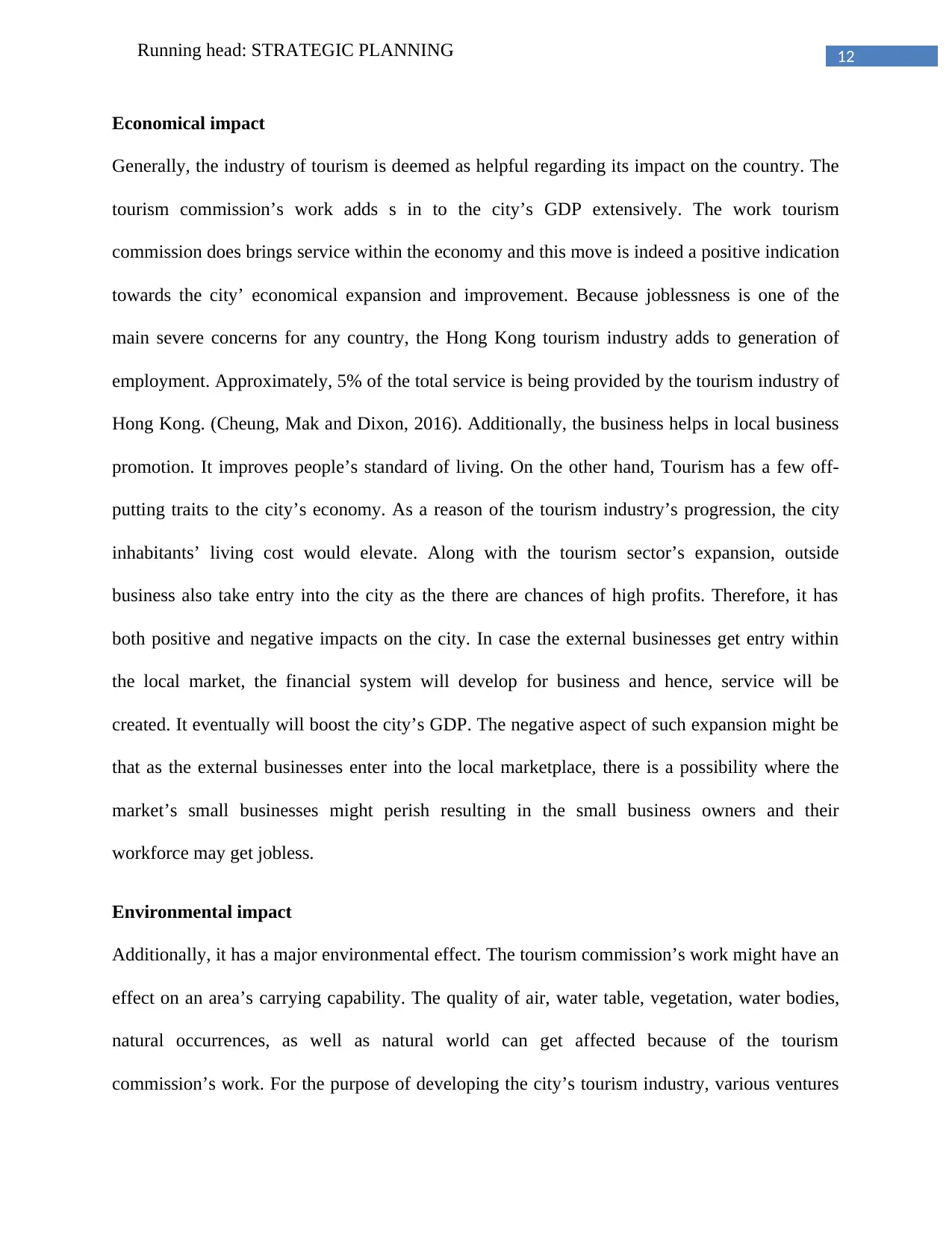
12Running head: STRATEGIC PLANNING
Economical impact
Generally, the industry of tourism is deemed as helpful regarding its impact on the country. The
tourism commission’s work adds s in to the city’s GDP extensively. The work tourism
commission does brings service within the economy and this move is indeed a positive indication
towards the city’ economical expansion and improvement. Because joblessness is one of the
main severe concerns for any country, the Hong Kong tourism industry adds to generation of
employment. Approximately, 5% of the total service is being provided by the tourism industry of
Hong Kong. (Cheung, Mak and Dixon, 2016). Additionally, the business helps in local business
promotion. It improves people’s standard of living. On the other hand, Tourism has a few off-
putting traits to the city’s economy. As a reason of the tourism industry’s progression, the city
inhabitants’ living cost would elevate. Along with the tourism sector’s expansion, outside
business also take entry into the city as the there are chances of high profits. Therefore, it has
both positive and negative impacts on the city. In case the external businesses get entry within
the local market, the financial system will develop for business and hence, service will be
created. It eventually will boost the city’s GDP. The negative aspect of such expansion might be
that as the external businesses enter into the local marketplace, there is a possibility where the
market’s small businesses might perish resulting in the small business owners and their
workforce may get jobless.
Environmental impact
Additionally, it has a major environmental effect. The tourism commission’s work might have an
effect on an area’s carrying capability. The quality of air, water table, vegetation, water bodies,
natural occurrences, as well as natural world can get affected because of the tourism
commission’s work. For the purpose of developing the city’s tourism industry, various ventures
Economical impact
Generally, the industry of tourism is deemed as helpful regarding its impact on the country. The
tourism commission’s work adds s in to the city’s GDP extensively. The work tourism
commission does brings service within the economy and this move is indeed a positive indication
towards the city’ economical expansion and improvement. Because joblessness is one of the
main severe concerns for any country, the Hong Kong tourism industry adds to generation of
employment. Approximately, 5% of the total service is being provided by the tourism industry of
Hong Kong. (Cheung, Mak and Dixon, 2016). Additionally, the business helps in local business
promotion. It improves people’s standard of living. On the other hand, Tourism has a few off-
putting traits to the city’s economy. As a reason of the tourism industry’s progression, the city
inhabitants’ living cost would elevate. Along with the tourism sector’s expansion, outside
business also take entry into the city as the there are chances of high profits. Therefore, it has
both positive and negative impacts on the city. In case the external businesses get entry within
the local market, the financial system will develop for business and hence, service will be
created. It eventually will boost the city’s GDP. The negative aspect of such expansion might be
that as the external businesses enter into the local marketplace, there is a possibility where the
market’s small businesses might perish resulting in the small business owners and their
workforce may get jobless.
Environmental impact
Additionally, it has a major environmental effect. The tourism commission’s work might have an
effect on an area’s carrying capability. The quality of air, water table, vegetation, water bodies,
natural occurrences, as well as natural world can get affected because of the tourism
commission’s work. For the purpose of developing the city’s tourism industry, various ventures
⊘ This is a preview!⊘
Do you want full access?
Subscribe today to unlock all pages.

Trusted by 1+ million students worldwide
1 out of 21
Related Documents
Your All-in-One AI-Powered Toolkit for Academic Success.
+13062052269
info@desklib.com
Available 24*7 on WhatsApp / Email
![[object Object]](/_next/static/media/star-bottom.7253800d.svg)
Unlock your academic potential
Copyright © 2020–2025 A2Z Services. All Rights Reserved. Developed and managed by ZUCOL.





